
| Photos From Wyoming Tales and Trails This page: Upton, "Best Town on Earth" The Red Onion Saloon. |
 |

| Photos From Wyoming Tales and Trails This page: Upton, "Best Town on Earth" The Red Onion Saloon. |
 |
|
|
|
About This Site |
British author A. G. Macdonnell, A Visit to America", MacMillan Company, New York, 1935, was less kind (actually he was downright crude and rude). The least crude thing he wrote of Upton was that it was a "Don Quixotic of a place." Of course, in the 1930's when Macdonnell passed by in the train, the town was less than impressive. The writers for the Works Progress Administration described half of the town as clinging to the pine-clad foothills while the other half of Upton ranges "out on a wind-swept, sage brush flat. Tar-paper shacks, brick stores, log, frame and brick dwellings are intermingled. The main sreet begins at the railroad and climbs the pine-cover knoll into the residential district." Wyoming: A guide to its history, highways, and people. At the time, the main street had fourteen buildings, four of which were saloons. But those who critized the town's motto missed its point. The sign is not about the physical characteristics of the town. The sign is about the people of the community who take pride in their willingness to work for the betterment of the town and each other. It also indicates that the residents do not take themselves to seriously. As observed in 1920 by the editor of the Gazette: As may be seen in the next photo, at some point the sign even became electrically illuminated for the benefit of night railroad passengers.
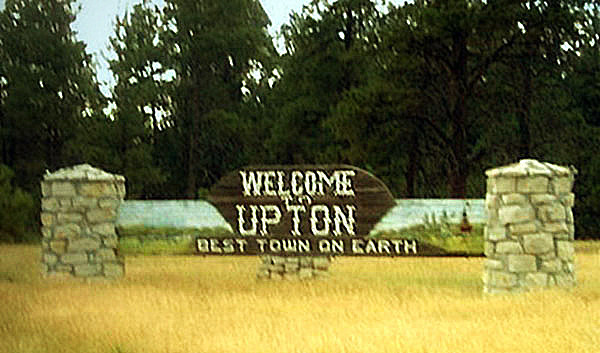 Welcoming Sign, Upton, Wyoming.
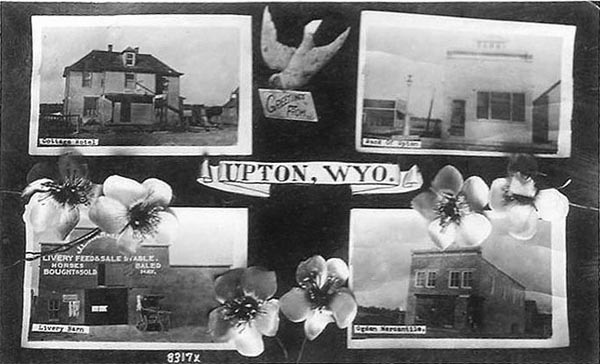 Principle buildings, Upton, Wyoming, 1909. Clockwise from upper left: Cottage Hotel on Railroad Ave. operated by A. G. Thomas, Bank of Upton, the Ogden Mercantile Company operated by W. B. Ogden and Amy B. Ogden, and the Livery Barn.
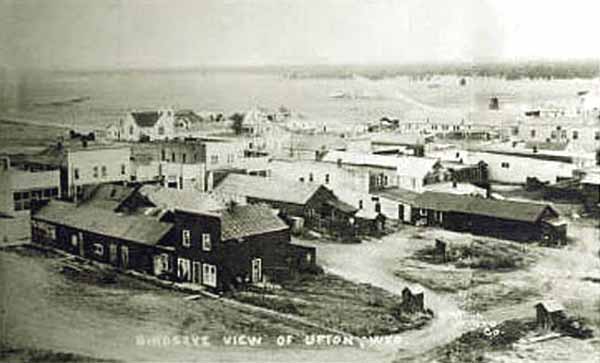 Upton, Wyoming, undated
C. P. Meek originally came to the Black Hills with its original settlement in 1876 as a bullwhacker on ox trains taking supplies from Cheyenne to Deadwood. Previously, he ran freight from Cheyenne to Ft. Fetterman. On one occasion in May 1876, between the Inyan Kara Creek and the Cheyenne River, the ox train was attacked by Indians and was saved only by a passing troop of cavalry. Meek then tried his hand at stock growing at Centennial Prairie, Dakota Territory, before coming to the Upton area. Upon Wyoming's attaining of statehood, Meek was elected to the State Legislature in 1912 and to the State Senate in 1919.
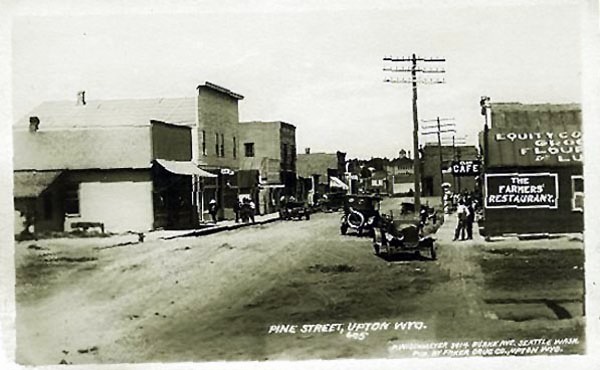 Pine Street, Upton, Wyoming, approx. 1920.
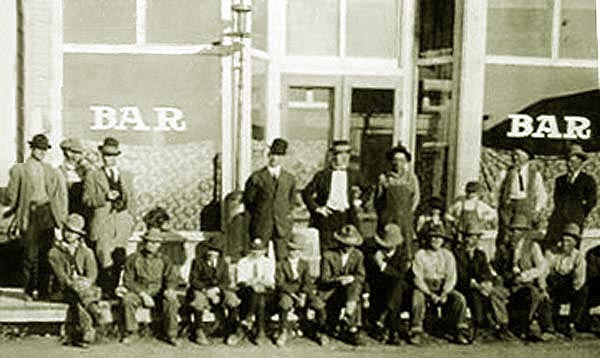 Customers lined up for picture taking, The Red Onion, approx. 1915.
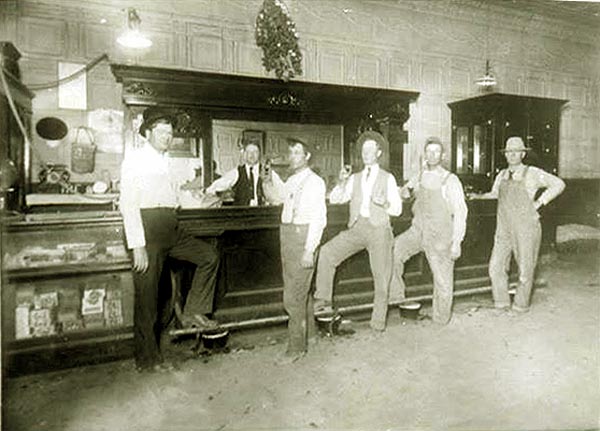 Interior, Red Onion, approx. 1914. Note the spittoons on the floor.
The Red Onion, located on Pine Street, was, as above noted, owned by Walter K. "Jarbo" Poulson (1880-1964). Poulson served as mayor from 1930 to 1936. The name "Red Onion," however, is not original to Upton. In the late 19th Century, "Red Onion" was a common name for saloons, particularly establishments which catered to railway men. Thus, the term "Red Onion" acquired a secondary meaning as hotel, bar, saloon, or other facility used by railway men. Upton was, of course, a railroad town. The most famous of the Red Onion Saloons were ones in Silver City, New Mexico Territory; Salt Lake City, and Skagway. The latter, in addition to quenching the thirst of miners during the Alaska Gold Rush catered to other needs on the second floor. Many, such as Skagway's and the one in Salt Lake City had dubious reputations. "Red Onions" were indeed so common, that a popular rag of the era was the Red Onion Rag , here as done by Horse Creek Cowboy.
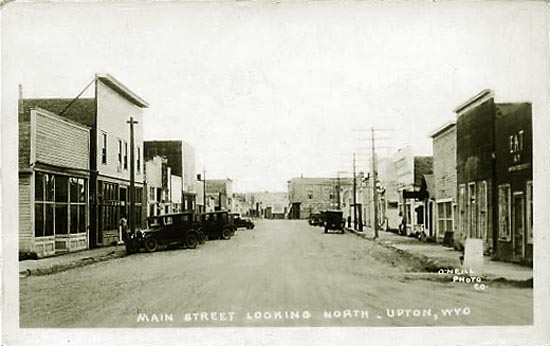 Upton, Wyoming, approx. 1928.
There may be some question as to why a saloon would be named the Red Onion. The best explanation is that the term "red onion" was used to described any establishment that was painted red. Numerous saloons across the west were painted red giving rise to many saloons named the "Red Front" as well as the "Red Onion." Infamous Caldwell, Kansas, as its height has both a "Red Front" and a "Red Light" saloon. And why were establishments painted red? It may be speculated that they were so painted for the same reason as barns, "Venetian Red" was the cheapest paint available. It came in kegs. When the writer was in high school, he discovered in his grandfather's barn a keg of red powder. It was the venetian red, still sitting in the barn from the 1920's. Other interesting relics were found such as wooden spoked automobile wheels. In his 1913, Paint Making and Color Grinding Charles L. Uebele noted:It is astonishing what nostrums have been sold under that name in the Far West, especially in red and brown. But we will omit a description of these and leave it to the reader's imagination, what this dope must have been when we state that such goods were sold to jobbing houses at from 30 to 35 cents per gallon in one-gallon tins at a time when linseed oil was 60 to 65 cents per gallon.The Red Onion advertised that it used "two stamp" booze. Two stamp whiskey was aged in its orginal kegs by the distiller or in a bonded warehouse. Government stamps were placed on the keg when the whiskey was first barrelled. After it was stored "straight" for the requisite time, another stamp placed on the barrel for the whiskey that had evaporated. It meant that the whiskey was straight aged and had not been "rectified" by a distributor. The name "Red Onion" lives on in Upton in the name of the local museum.
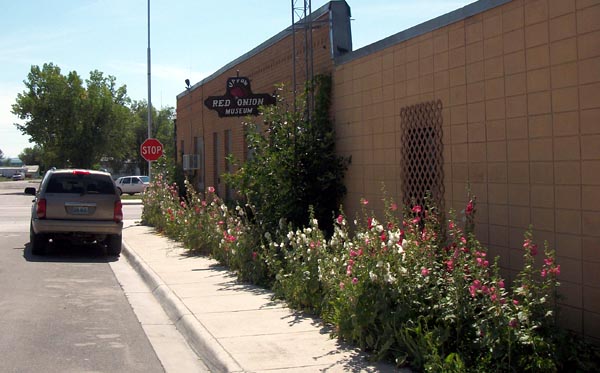 Sign for Red Onion Museum, 2013. Photo by Geoff Dobson.
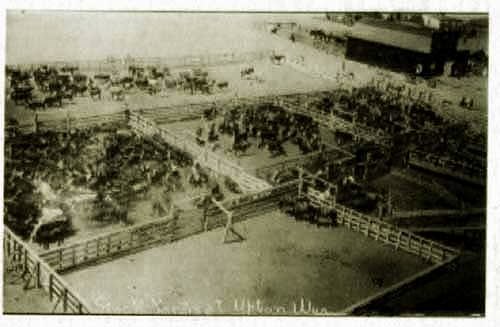 Stockyards, Upton, undated.
When the railroad reached Iron Town it became the typical "end of tracks" settlement. With a supply of pine to the north, a tie camp provided railroad ties for the railroad. With open range to the south, the town became a convenient shipping point for livestock. A siding with sheep pens and shearing sheds was esablished. As a result of becoming a major shipping point for sheep, the name of Iron Town was changed to Merino. However, Another town in Colorado bore the same name and thus the town was again renamed after George S. Upton, a surveyor for the railroad. There is, however, some uncertainty as to the naming of the town after George Upon, some sources contend that it was named for A. Z. Upon. |